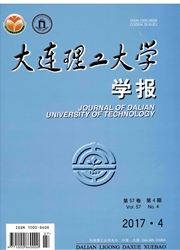

 中文摘要:
中文摘要:
为分离出结构振动特征参数改变中环境因素的影响,并通过剩余组分识别结构损伤发生时刻,将一种称为辛几何谱分析法(SGSA)的时间序列分解方法应用于环境因素影响下结构健康监测的振动特征参数识别中。首先介绍了SGSA的理论推导及实现过程。其次,采用SGSA法将一个构造的正弦函数分解为独立的具有特定物理意义的叠加组分,说明SGSA方法的有效性,并通过对一组环境温度数据的处理分析,将SGSA与小波变换和经验模态分解(EMD)的处理结果进行比较。最后,对一简支钢梁在温度及损伤共同影响下的一阶频率数据进行处理分析。结果表明:SGSA法能更好地分离出数据中的趋势项成分,并且将SGSA方法用于环境因素影响下的结构损伤识别中,有很好的可行性及有效性。
 英文摘要:
英文摘要:
In order to separate the environmental influences from the raw data and identify structural damage using the remaining component,The Symplectic Geometry Spectrum Analysis(SGSA) was applied to parameter identification in structural health monitoring.First,the theoretical basis and the implementation process of the SGSA was introduced.Second,to illustrate the ability of the SGSA as a time series decomposition method that can decomposing a time series into a set of independent components,a constructed sine function was analysed.Furthermore,one-year temperature data of Beijing was analysed by SGSA and two other methods,namely Wavelets and empirical modal decomposition.The results shows that SGSA can extract temperature trend much better than the other two methods and the original temperature can be represented with less components by SGSA.Finally,a computer-simulated data of a simply supported beam was analysed by this method to demonstrate the effectiveness and reliability of the proposed technique.Numerical simulation and experiments show that the method is promising to detect structural damage in the presence of environmental and operational variations.
 同期刊论文项目
同期刊论文项目
 同项目期刊论文
同项目期刊论文
 Experimental behaviour of recycled aggregate concrete filled stainless steel tube stub columns and b
Experimental behaviour of recycled aggregate concrete filled stainless steel tube stub columns and b An efficient approach for frequency-domain and time-domain hydrodynamic analysis of dam-reservoir sy
An efficient approach for frequency-domain and time-domain hydrodynamic analysis of dam-reservoir sy Analysis of quadruple corner-cut ridged square waveguide using a scaled boundary finite element meth
Analysis of quadruple corner-cut ridged square waveguide using a scaled boundary finite element meth Short-Crested Waves Interaction with A Concentric Porous Cylinder System with Partially Porous Outer
Short-Crested Waves Interaction with A Concentric Porous Cylinder System with Partially Porous Outer A Three-Dimensional Model of the Effective Electromechanical Impedance for an Embedded PZT Transduce
A Three-Dimensional Model of the Effective Electromechanical Impedance for an Embedded PZT Transduce Associated Generalized Plasticity Framework for Modeling Gravelly Soils Considering Particle Breakag
Associated Generalized Plasticity Framework for Modeling Gravelly Soils Considering Particle Breakag Noise Smoothing for Structural Vibration Test Signals Using an Improved Wavelet Thresholding Techniq
Noise Smoothing for Structural Vibration Test Signals Using an Improved Wavelet Thresholding Techniq Bond behaviour of deformed bars in self-compacting lightweight concrete subjected to lateral pressur
Bond behaviour of deformed bars in self-compacting lightweight concrete subjected to lateral pressur ANSYS implementation of damping solvent stepwise extraction method for nonlinear seismic analysis of
ANSYS implementation of damping solvent stepwise extraction method for nonlinear seismic analysis of High frequency S wave envelope synthesis using a multiple nonisotropic scattering model: application
High frequency S wave envelope synthesis using a multiple nonisotropic scattering model: application Seismic Response of Single-Degree-of-Freedom Systems Representing Low-Ductility Steel Concentrically
Seismic Response of Single-Degree-of-Freedom Systems Representing Low-Ductility Steel Concentrically Scaled boundary FEM solution of short-crested wave interaction with a concentric structure with doub
Scaled boundary FEM solution of short-crested wave interaction with a concentric structure with doub Dynamic interaction numerical models in the time domain based on the high performance scaled boundar
Dynamic interaction numerical models in the time domain based on the high performance scaled boundar A precise integration approach for dynamic impedance of rigid strip footing on arbitrary anisotropic
A precise integration approach for dynamic impedance of rigid strip footing on arbitrary anisotropic The First-Order Symplectic Euler Method for Simulation of GPR Wave Propagation in Pavement Structure
The First-Order Symplectic Euler Method for Simulation of GPR Wave Propagation in Pavement Structure Symplectic partitioned Runge-Kutta methods for two-dimensional numerical model of ground penetrating
Symplectic partitioned Runge-Kutta methods for two-dimensional numerical model of ground penetrating Short-crested waves interaction with a concentric cylindrical structure with double-layered perforat
Short-crested waves interaction with a concentric cylindrical structure with double-layered perforat An experimental study on the performance of self-compacting lightweight concrete exposed to elevated
An experimental study on the performance of self-compacting lightweight concrete exposed to elevated Numerical assessment of liquefaction mitigation effects on residential houses: Case histories of the
Numerical assessment of liquefaction mitigation effects on residential houses: Case histories of the Three-dimensional investigation of wave-pile group interaction using the scaled boundary finite elem
Three-dimensional investigation of wave-pile group interaction using the scaled boundary finite elem Structural Health Monitoring of a Tall Building during Construction with Fiber Bragg Grating Sensors
Structural Health Monitoring of a Tall Building during Construction with Fiber Bragg Grating Sensors Numerical analysis of dislocations of the face slabs of the Zipingpu Concrete Faced Rockfill Dam dur
Numerical analysis of dislocations of the face slabs of the Zipingpu Concrete Faced Rockfill Dam dur A coupled thermo-hydrologic-mechanical damage model and associated application in a stability analys
A coupled thermo-hydrologic-mechanical damage model and associated application in a stability analys Comments on placement of sensors in operational modal analysis for truss bridges in Mechanical Syste
Comments on placement of sensors in operational modal analysis for truss bridges in Mechanical Syste Experimental Study on Bond Behavior of Deformed Bars Embedded in Concrete Subjected to Biaxial Later
Experimental Study on Bond Behavior of Deformed Bars Embedded in Concrete Subjected to Biaxial Later Numerical modelling of wave interaction with a concentric cylindrical system with an arc-shaped poro
Numerical modelling of wave interaction with a concentric cylindrical system with an arc-shaped poro Sensor placement optimisation for Dalian international trade mansion focusing on application demands
Sensor placement optimisation for Dalian international trade mansion focusing on application demands Study on crack curving and branching mechanism in quasi-brittle materials under dynamic biaxial load
Study on crack curving and branching mechanism in quasi-brittle materials under dynamic biaxial load Experiment and modeling on axial behavior of carbon fiber reinforced polymer confined concrete cylin
Experiment and modeling on axial behavior of carbon fiber reinforced polymer confined concrete cylin 期刊信息
期刊信息
